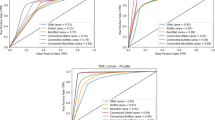Abstract
Breast cancer is an extremely serious and lethal form of cancer. It is the second most common cancer among Indian women in rural areas. Early breast cancer detection can considerably enhance the effectiveness of treatment. Early detection of symptoms and signs is the most important technique to effectively treat breast cancer, as it enhances the odds of receiving an earlier, more specialist care. As a result, it has the possibility to significantly improve survival odds by delaying or entirely eliminating cancer. Mammography is a high-resolution radiography technique that is an important factor in avoiding and diagnosing cancer at an early stage. Automatic segmentation of the breast part using mammography pictures can help reduce the area available for cancer search, while also saving time and effort compared to manual segmentation. Previous studies have utilized convolutional and deconvolutional neural networks with autoencoder-like architecture (CN-DCNN) to perform automated breast region segmentation in mammography images. We present Automatic SegmenAN, an end-to-end unique adversarial neural network for the task of segmenting medical images, in this paper. Image segmentation necessitates extensive, pixel-level labeling, a standard GAN's discriminator's single scalar real/fake output may be inefficient in providing steady and appropriate gradient feedback for the networks. Our approach entails using a novel adversarial critic network and a multi-scale L1 loss function to prompt the critic and segmentor for acquiring local as well global features which encompass spatial relationships among pixels at both short and long ranges, instead of employing a segmentor which is a fully convolutional neural network. We demonstrate that an Automatic SegmenAN perspective is more up to date and reliable for segmentation tasks than any latest U-net segmentation technique.









Similar content being viewed by others
References
Siegel RL, Miller KD, Jemal A. Cancer statistics, 2019. CA: a cancer journal for clinicians. 2019;69(1):7–34.
Klein EA, Richards D, Cohn A, Tummala M, Lapham R, Cosgrove D, Chung G, et al. Clinical validation of a targeted methylation-based multi-cancer early detection test using an independent validation set. Ann Oncol. 2021;32(9):1167–77.
Mittra I, Mishra GA, Dikshit RP, Gupta S, Kulkarni VY, Shaikh HK, Shastri SS, Hawaldar R, Gupta S, Pramesh CS and Badwe RA. Effect of screening by clinical breast examination on breast cancer incidence and mortality after 20 years: prospective, cluster randomised controlled trial in Mumbai. BMJ. 2021;372.
Canelo-Aybar C, Posso M, Montero N, Sola I, Saz-Parkinson Z, Duffy SW, Follmann M, Grawingholt A, Giorgi Rossi P, Alonso-Coello P. Benefits and harms of annual, biennial, or triennial breast cancer mammography screening for women at average risk of breast cancer: a systematic review for the European Commission Initiative on Breast Cancer (ECIBC). Br J Cancer. 2022;126:673–88.
Mashekova A, Zhao Y, Ng EY, Zarikas V, Fok SC, Mukhmetov O. Early detection of the breast cancer using infrared technology–a comprehensive review. Thermal Sci Eng Progr. 2022;27:101142.
Gupta KK, Vijay R, Pahadiya P, Saxena S. Use of novel thermography features of extraction and different artificial neural network algorithms in breast cancer screening. Wirel Pers Commun. 2022;1:1–30.
Fujioka T, Katsuta L, Kubota K, Mori M, Kikuchi Y, Kato A, Oda G, Nakagawa T, Kitazume Y, Tateishi U. Classification of breast masses on ultrasound shear wave elastography using convolutional neural networks. Ultrason Imaging. 2020;42(4–5):213–20.
Priyadharsini MS, Sathiaseelan JGR. The new robust adaptive median filter for denoising cancer images using image processing techniques. Indian J Sci Technol 2023;16(35).
Punn NS, Agarwal S. RCA-IUnet: A residual cross-spatial attention guided inception U-Net model for tumor segmentation in breast ultrasound imaging. arXiv:2108.02508 (2021).
Chaudhuri A. Hierarchical modified Fast R-CNN for object detection. Informatica. 2021;45(7):67–81.
Papadeas I, Tsochatzidis L, Amanatiadis A, Pratikakis I. Real-time semantic image segmentation with deep learning for autonomous driving: a survey. Appl Sci. 2021;11(19):8802.
Salama WM, Aly MH. Deep learning in mammography images segmentation and classification: automated CNN approach. Alex Eng J. 2021;60(5):4701–9.
Rashmi R, Prasad K, Udupa CB. Breast histopathological image analysis using image processing techniques for diagnostic purposes: a methodological review. J Med Syst. 2022;46:1–24.
Baccouche A, Garcia-Zapirain B, Castillo Olea C, Elmaghraby AS. Connected-UNets: a deep learning architecture for breast mass segmentation. NPJ Breast Cancer. 2021;7(1):1–12.
Chukwu JK, Sani FB, and Nuhu AS. Breast cancer classification using deep convolutional neural networks. FUOYE J Eng Technol. 2021;6(2)
Swain M, Kisan S, Chatterjee JM, Supramaniam M, Mohanty SN, Jhanjhi NZ, Abdullah A. Hybridized machine learning based fractal analysis techniques for breast cancer classification. Int J Adv Comp Sci Appl. 2020;11(10):179–84.
Nanglia S, Ahmad M, Khan FA, Jhanjhi NZ. An enhanced Predictive heterogeneous ensemble model for breast cancer prediction. Biomed Signal Process Control. 2022;72:103279.
Al-Dhabyani W, Gomaa M, Khaled H, Aly F. Deep learning approaches for data augmentation and classification of breast masses using ultrasound images. Int J Adv Comput Sci Appl. 2019;10(5):1–11.
Saber A, Sakr M, Abo-Seida OM, Keshk A, Chen H. A novel deep-learning model for automatic detection and classification of breast cancer using the transfer-learning technique. IEEE Access. 2021;9:71194–209.
Author information
Authors and Affiliations
Corresponding author
Ethics declarations
Conflict of interest
The authors have no conflict of interest to declare. On behalf of all co-authors, the corresponding author shall bear full responsibility for the submission.
Additional information
Publisher's Note
Springer Nature remains neutral with regard to jurisdictional claims in published maps and institutional affiliations.
This article is part of the topical collection “Industrial IoT and Cyber-Physical Systems” guest edited by Arun K Somani, Seeram Ramakrishnan, Anil Chaudhary and Mehul Mahrishi.
Rights and permissions
Springer Nature or its licensor (e.g. a society or other partner) holds exclusive rights to this article under a publishing agreement with the author(s) or other rightsholder(s); author self-archiving of the accepted manuscript version of this article is solely governed by the terms of such publishing agreement and applicable law.
About this article
Cite this article
Priyadharsini, M.S., Sathiaseelan, J.G.R. Segmentation of Mammography Breast Images Using Automatic SEGMEN Adversarial Network with UNET Neural Networks. SN COMPUT. SCI. 5, 118 (2024). https://doi.org/10.1007/s42979-023-02422-8
Received:
Accepted:
Published:
DOI: https://doi.org/10.1007/s42979-023-02422-8




